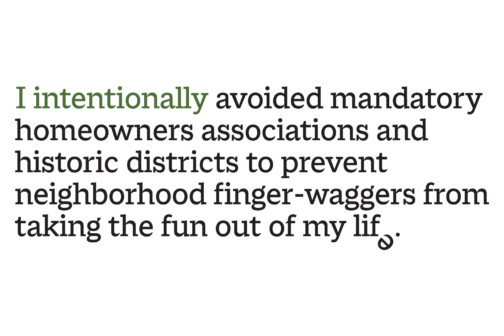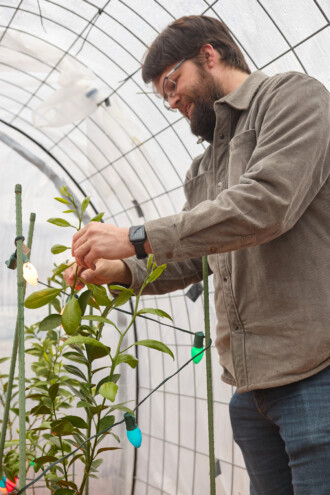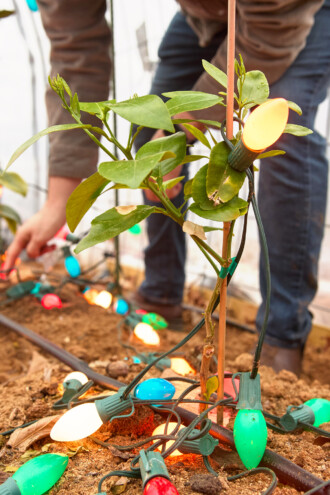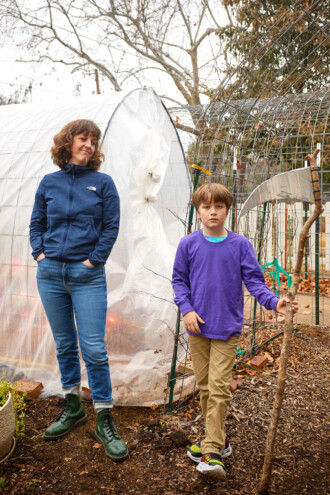I come from a family of fruit growers. My maternal grandfather, a minister raised in Texas but retired in California, kept an extensive garden where he grew guavas, plums, tomatoes, and dozens of other delights. My mother was quick to remind me how, when she was a child, she had to pick 500 weeds in her father’s garden every morning before school, so I should consider myself lucky to merely have to take out the trash. I also have fond memories of secretly picking apples and pears from my father’s small orchard at our country home. He often complained that the squirrels got his fruit no matter how he tried to thwart them, and he eventually gave up on the orchard. The purloined fruit, until it was discontinued, tasted far superior to supermarket produce.
I had the opportunity to continue the fruit-growing tradition of my forefathers when a mulberry tree in our front yard dropped several large limbs on our Old East Dallas house and had to be taken down. Where once nothing but the scrubbiest ground cover would grow in the near-constant shade, I now found myself with 1,500 square feet of sunny, newly reclaimed agricultural land. This being the early days of the pandemic, I had more free time than usual and set about converting our front yard into a full-fledged horticultural operation, tilling the earth and bringing in truckloads of freshly chipped arborist cuttings.
What started with a few apple trees planted in a tidy row along the front walk has grown (my wife would say metastasized) over time. Apples? Sure, they’re good, but Texas isn’t the best place for apples, what with the cotton root rot and the heat, so I really needed some peaches just in case the apples keeled over. Peaches? They’re fine, but peaches are kind of one-dimensional when you think about it, so I complemented them with some plums. But plums take so long to bear. I really had to add some quick wins like an elderberry bush, a fig, and a mulberry. Also, I’d dishonor the legacy of T.V. Munson if I didn’t plant at least a few grapevines, right? That means I had to build a grape trellis system, too. It turned out to be an ordeal to water all these plants, and we need to save water, so really it was just the responsible thing to do to install a drip irrigation system. By the way, did you know that jujubes, pomegranates, and persimmons can grow quite well in Texas? Now add grafting, espaliers, retaining walls, and pest control—I’ve got a lot of hobby to tackle.
So it continued, with new plants taking root across the entirety of the front yard while I schemed to fit in just one more shrub, tree, or vine. For three years, this gardening bliss persisted, until my hubris, spurred on by social media influencers with monikers like The Millennial Gardener, led me to take on an entirely new challenge. I decided to ignore the USDA hardiness maps and plant five varieties of citrus (two oranges, a satsuma, a grapefruit, and a kumquat). My wife merely shook her head and pointed out that we don’t live in California and perhaps I shouldn’t swim upstream so often and that’s why my life is always so difficult.
Mature citrus trees will tolerate moderately cold temperatures, enduring lows of 28 degrees (or less for some tougher varieties) before they begin to suffer. Texas, bless her heart, has such unpredictable swings in temperature during the winter that growing citrus in the ground anywhere north of the Rio Grande Valley is considered folly at best. Wise home citrus growers keep their trees in pots and wheel them into the garage each time the forecast drops into the 20s. Well, I didn’t have a garage, but if The Millennial Gardener can do it, so could I!
Since I wasn’t inclined to spend thousands on a professional purpose-built greenhouse, I dived into the somewhat eerie world of homesteading, where you can find all manner of questionably built farm structures that enthusiastic homesteaders use to extend their growing season into the winter months. Using these designs, I erected my very own cattle panel greenhouse in my front yard to protect my citrus during the winter. This ended up costing me double my budget and taking twice as much time as I wanted. But I wasn’t about to let my wife win an argument now or ever, so I kept at it until my 16-foot-long, 6-foot-tall greenhouse, clothed in high-quality farm plastic, finally graced our yard as my spouse duly noted my feat of engineering.
I considered my thoroughly tilled and mulched yard to be a great improvement over the neglected lawn that preceded it. Something about growing up in rural Kansas with 40 acres of grass, woods, and pasture to care for left me with a contemptuous attitude toward lawns. They are just another maintenance job in a world already filled with so much toil. I’ve always done as little as I could get away with in lawn care. I cut the lawn with a reel mower, never watered, and certainly never, ever applied any kind of fertilizer, weed killer, or other lawn care product. In short, I did just the minimum to maintain social decorum and forestall visits from the roving bands of Code Compliance officers who, it would turn out, would come to feature so prominently in my life, thanks to my no-good neighbors.
When I bought my house, I intentionally avoided mandatory homeowners associations and historic districts to prevent neighborhood finger-waggers from taking the fun out of my life. A committed finger-wagger has dozens of pages of city regulations with which to bother you to death. Spend some time sifting through the City Code, and you will soon find that there are so many rules that almost assuredly you have violated one of them. So it came as not a huge surprise one day when a friendly member of the Dallas Code Compliance team knocked on my door.
He let me know there may be an issue with the recently erected greenhouse, and they would be opening an investigation into the matter. Being something of a City Code enthusiast myself, I knew I was pushing the boundaries with my various shade structures, tree stakes, trellises, retaining walls, irrigation systems, and greenhouses. Still, I explained to the Code Compliance officer that, indeed, much has been written about the American love affair with the front lawn and its ill effects on biodiversity, free speech, and the environment, not to mention the pollinators! As it turns out, though, all the think pieces, no matter how compelling, mean little to the humble Code Compliance officer.
I know that such investigations are almost always driven by citizen complaints, and I took inventory of the likely culprits. Could it have been the neighbor who has held a grudge against me ever since I caught and deported a stray cat in my backyard? (How was I to know she was feeding all the stray cats and considered them her charges?) Or perhaps it was another who I got in a tussle with after they poured a driveway on my side of the property line? After a few cordial conversations with the Code Compliance officer, the issue was escalated to a supervisor. He delivered the bad news: the greenhouse is in the “required front yard,” where no structures are permitted (think pieces notwithstanding).
The City Code does allow small hoop houses, no more than 4 feet tall, in the front yard in some cases, but mine stands nearly 6 feet tall to accommodate my height and the trees’ growth. Normally this would have been the end of it. I would have to take down my greenhouse because there it is plain as day in the City Code that no structures above 4 feet are allowed in the required front yard. I thought my citrus would be left to shiver in the cold—until I remembered the recent work of our freedom-loving legislators in Austin.
The state of Texas in November expanded its “Right to Farm” statute that protects farmers from nuisance lawsuits and city regulations. I am not an attorney, but it seems to me that this statute is written rather broadly and makes no distinction between commercial and home-scale agriculture. The constraints it places on cities are significant; they cannot regulate an agricultural operation unless a series of steps is undertaken, including a health report prepared by a city official to show an operation presents a danger to the public, followed by an official City Council vote.

In short, I could run a small hog farm and keep roosters crowing from dawn till dusk, and the city of Dallas can’t do a thing about it unless officials jump through all the hoops designed to discourage them from regulating farming. While this goes beyond what I consider reasonable, the law serves me well in this case. The city cannot lawfully prevent me from running my agricultural operation, including the offending greenhouse, until it gets its ducks in a row.
I sent the Code Compliance supervisor a letter reminding him of all this, thinly veiling my “na-na na-na boo-boo” with references to the state statute. I’d hoped that would be the end of it, but I underestimated the doggedness of the Code Compliance office. I found my home subject to several additional visits from Code Compliance, including one during which they asked to search my backyard for violations (please return with a warrant, thank you very much) and another, two days after Christmas, attended by an assistant director from the city.
As of this writing, I have not received any more communications from the city about my greenhouse, so it remains in place, swaying gently in the wind on gusty days. I am pleased to report that, aided by several strings of incandescent Christmas lights, it maintained a balmy temperature of 28 degrees even at the coldest point of the mid-January freeze, and so my citrus live to see another season. It could be that a future neighbor will start raising alpacas or open a feedlot next to me, and I’ll curse the Right to Farm Act, but for now I’ll raise a ruby red grapefruit in honor of private property rights.
This story originally appeared in the March issue of D Magazine with the headline “Adventures in Urban Farming.” Write to [email protected].













